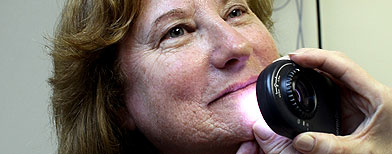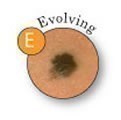Skin cancer: Recognizing the trouble spots
Could that bump, sore or mole be a sign of something sinister? What you should know about spotting skin cancer.Already one of the most common cancers in the world, the incidence of skin cancer is on the rise. Currently, experts estimate that one in three new cancer cases is skin cancer. Luckily, its also one of the most curable forms of cancer but early detection is key.
Heres what you need to know to spot trouble:
Recognizing the signs
How can you tell a benign issue from a trouble spot? Its up to the experts to make a diagnosis with a thorough examination and often a biopsy but here are some signs to keep in mind:
Because melanoma stars with moles, experts recommend minding your ABCDEs, that is:
- Asymmetry:one half of the mole looks different than the other in shape, colour or texture.
- Borders:irregular borders, that is edges that are notched, blurred, or jagged.
- Colour that is uneven:most moles are shades of tan and browns. However, trouble moles may have grey, red, pink, blue or black and blue patches.
- Diameter:Melanomas can be small, but most are more than 6 millimetres or 1/4 inch in diameter about the size of a pea or the eraser on your pencil.
- Evolving:moles do go through harmless changes throughout our lives, but a change could signal trouble. If you spot changes, dont panic but do talk to your doctor.
What about non-melanoma skin cancers? Watch out for:
- A lump that is firm and red, or a lump that is small, smooth, waxy or shiny and pale.
- A lump or sore that bleeds or forms a crust or scab.
- A rough and scaly patch that may be red or brown in colour.
- A flat red spot that is rough, dry and scaly. The patch may itch, or hurt to touch.
However, if you do have any of these signs, it doesnt necessarily mean you have skin cancer. Its a good idea to keep an eye on your skin and talk to your doctor if you see any suspicious signs or changes.
Your doctor should also take a look on a regular basis studies have shown that experts pick up more cases of skin cancers than individuals. Another option: Ask around about free skin cancer screenings in your area. Some clinics offer mole mapping services for a fee.
Skin cancer: The big three
Think skin cancer is all about odd moles? One type is:melanoma. This most dangerous form of skin cancer starts in the melanocytes (the cells that make melanin, the pigment that colours our skin and hair). If left untreated, tumours can grow deep into the skin and metastasize spreading the cancer to other parts of the body.
Less risky but not to be under estimated are non-melanoma skin cancers. Two of the most common kinds include:
Basal cell carcinoma(BCC) is a slow-growing tumour that starts in the cells at the base of our top layer of skin, the epidermis. BCC is the most common kind of skin cancer and often appears as a bump on the skin. While it doesnt usually metastasize, it can affect surrounding tissues and cause disfigurement.
Squamous cell carcinoma(SCC) also occurs in the epidermis but often appears as a scaly patch or sore that crusts over or bleeds. Its the second most common type of skin cancer, and can spread in some cases.
Non-melanoma skin cancers are usually treated by dermatologists, and are often not noted in cancer statistics because they dont usually involve hospital stays or complications. However, the Canadian Cancer Society forecasts 74,100 cases of non-melanoma skin cancers will be diagnosed in 2011.
Who is most at risk?
Weve heard it before: experts consider UV ray exposure to be the top cause of most kinds of skin cancer whether it comes from the sun or a tanning bed. The more exposure you get, the higher the risk especially if youve had severe sunburns in the past. Many skin cancers occur on parts of the skin that get regular exposure like the back, face, arms and lower legs. People who are often outdoors or work outdoors have an increased risk.
What else should you consider?
- Complexion:people with light-coloured skin, hair and eyes are more likely to develop skin cancer. If you burn before you tan, you could be at higher risk.
- Age:as with most cancers, the risk increases with age. Skin cancer is most likely to show up after age 40.
- Genetics:if you have a family history of melanoma, youre more likely to develop it especially if you have atypical moles.
- Number of moles:more moles could mean a higher risk for melanoma, especially if you have more than 50 or have some large or atypical ones.
- Skin trauma:in some cases, scars, burns or exposure to radiation or chemicals can contribute to non-melanoma skin cancers as can chronic inflammation of the skin.
- Weakened immune systemdue to an organ transplant, chemotherapy or an illness like lymphoma for HIV/AIDS could contribute to a type of skin cancer known as Kaposis sarcoma.
However, dont be lulled into a false sense of security if you dont have many of these risk factors. Anyone can develop skin cancer at any age. Likewise, people who have some of these risk factors wont develop the disease.
Can we prevent it?
There are a lot of risks we cant control, but we can tackle the most common one: sun and UV exposure. You know the drill: wear sunscreen (plenty of it, and re-applied often), skip the tanning beds and stay out of the sun from 10:00 am to 4:00 pm. Sunglasses, a hat and protective clothing are also a must.
However, be aware that your summer clothing may be too light to provide much coverage. Some sources recommend holding up the fabric to see how much light comes through thats how much sun is getting through to your skin. If youre shopping for protective clothing, look for tightly-woven fabrics, dark colours and certain fabrics (light high-sheen polyester or unbleached cotton) that block more light.
Some clothing tags even list the items Ultraviolet Protection Factor (UPF) a measure that tells you how much of the suns UV rays reach your skin. Experts say to aim for a UPF of 50 or above: that means that means one 1/50th (or 2 per cent) of the suns UV radiation reaches your skin. (For more details, see the Skin Cancer Foundations advice onProtective Clothing.)
These protective measures are even more important for younger adults and children. Its not just the many years of cumulative exposure ahead: The damaged ozone layer means more UV is reaching us. Experts estimate that Canadians born during the 1990s are two to three times more likely to develop skin cancer than Canadians born during the 1960s.
While any kind of cancer can be scary, skin cancer doesnt have to take a devastating toll. Taking the time to prevent sun exposure and watch for warning signs means a better outcome.
How to examine your skin
The first line of defense against skin cancer starts with you. Examine your skin on a regular basis for signs of skin cancer and consult a dermatologist if you notice anything suspicious. These simple steps can helpensure that skin cancer is diagnosed in its earliest, most treatable stage. Below you will find informationabout how to examine your skin and what signs to look for.
How to perform a self-exam

Melanomas usually are greater than 6mm (the size of a pencil eraser) when diagnosed, but they can be smaller.
www.keralites.net |
__._,_.___
KERALITES - A moderated eGroup exclusively for Keralites...
To subscribe send a mail to Keralites-subscribe@yahoogroups.com.
Send your posts to Keralites@yahoogroups.com.
Send your suggestions to Keralites-owner@yahoogroups.com.
To unsubscribe send a mail to Keralites-unsubscribe@yahoogroups.com.
Homepage: www.keralites.net
To subscribe send a mail to Keralites-subscribe@yahoogroups.com.
Send your posts to Keralites@yahoogroups.com.
Send your suggestions to Keralites-owner@yahoogroups.com.
To unsubscribe send a mail to Keralites-unsubscribe@yahoogroups.com.
Homepage: www.keralites.net
.
__,_._,___






















No comments:
Post a Comment